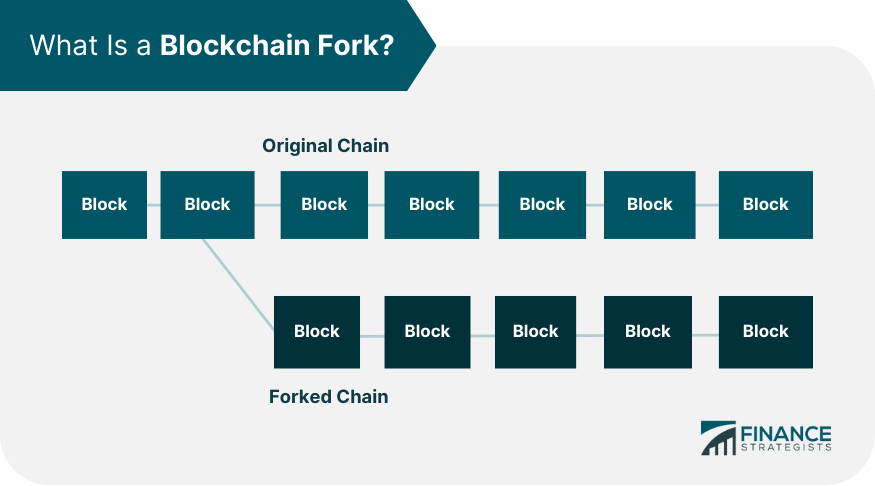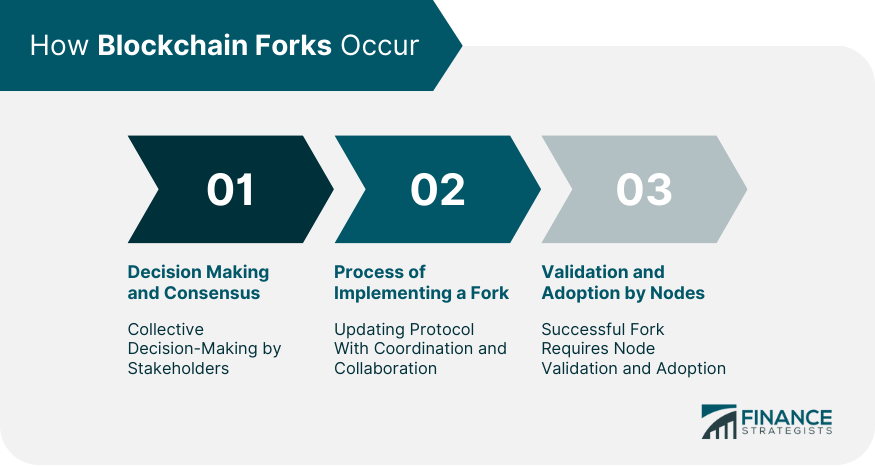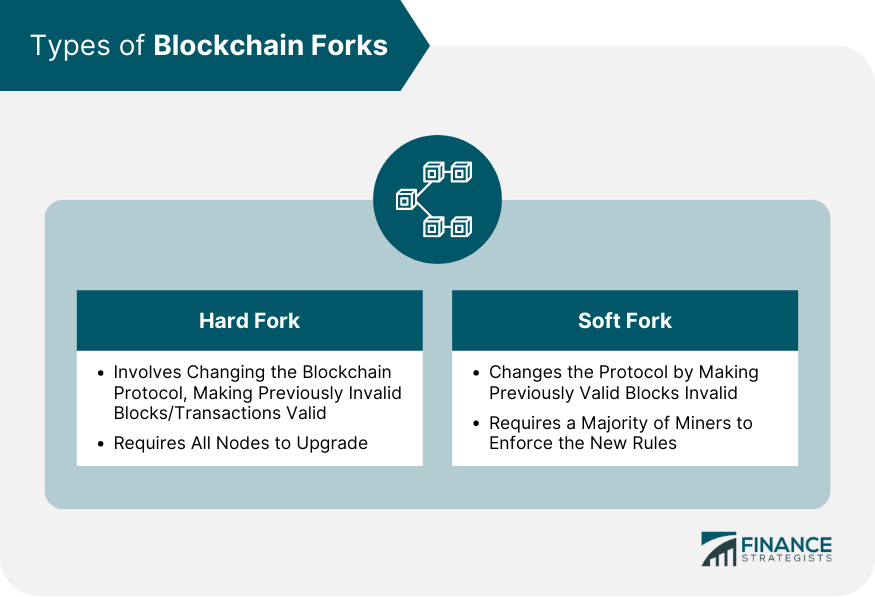Blockchain forks refer to significant divergences or splits in the blockchain protocol, resulting in the creation of two separate versions of the blockchain. A fork occurs when there are substantial changes or upgrades to be implemented in the blockchain's underlying technology and rules. In essence, a blockchain fork represents a branching point where the blockchain's history diverges into two or more paths. These paths can have different rules, features and sometimes even separate cryptocurrencies. Forks are an integral part of the evolutionary process in blockchain technology, allowing for improvements, scalability enhancements, bug fixes, and the exploration of different consensus mechanisms. They are significant events that impact the blockchain community, its stakeholders, and the value and direction of associated cryptocurrencies. Blockchain forks plays a crucial role in enhancing functionalities and fixing vulnerabilities in the system. They help improve the security and efficiency of the blockchain and are often necessary to address performance-related issues. The decision to perform a fork often comes down to governance within the blockchain community. Various stakeholders, including developers, miners, and node operators, contribute to the decision-making process. If there is consensus on the changes to be implemented, a fork may occur to update the protocol. Blockchain forks are the result of collective decision-making within the blockchain community. Key stakeholders, including developers, miners, and node operators, engage in consensus mechanisms to determine whether a fork is necessary and how it should be implemented. Implementing a blockchain fork involves updating the protocol and ensuring that the changes are adopted by the majority of nodes within the network. The process may require coordination, communication, and collaboration among various participants. For a fork to be successful, the updated protocol must be validated and adopted by a significant portion of the blockchain nodes. This validation process ensures the continuity and consensus of the new blockchain version. Within the umbrella of blockchain forks, there are two main types: hard forks and soft forks. Each has its unique characteristics, consequences, and instances of occurrence. A hard fork is a type of fork that involves a change to the blockchain protocol that makes previously invalid blocks/transactions valid, or vice-versa. It requires all nodes or users to upgrade to the latest version of the protocol software. The impact of a hard fork can be profound. When a hard fork occurs, it results in a permanent divergence from the previous version of the blockchain, and nodes running the previous version will no longer be accepted by the new network. This can create a split in the network, resulting in two separate blockchains and cryptocurrencies. In contrast, a soft fork is a change to the protocol wherein only previously valid blocks are made invalid. With a soft fork, only a majority of miners are required to upgrade to enforce the new rules, as opposed to a hard fork which requires almost all nodes to upgrade and agree on the new version. The impact of a soft fork can be less disruptive than a hard fork. As it's backward-compatible, it doesn't require all nodes in the network to upgrade. However, it does carry a risk of resulting in two blockchains if the majority of miners don't enforce the new rules. The history of blockchain is marked by several notable forks that have shaped the trajectory of certain cryptocurrencies. Bitcoin Cash is perhaps the most famous example of a hard fork. It occurred in August 2017 as a result of a disagreement in the Bitcoin community about how to handle scaling issues. This fork resulted in a new cryptocurrency, Bitcoin Cash, which exists alongside the original Bitcoin. Another notable example is the Ethereum Classic, which was created following a hard fork in the Ethereum blockchain in 2015. The fork occurred as a response to a hack in the Ethereum network, leading to a divergence in the community and the creation of Ethereum Classic. SegWit, or Segregated Witness, was implemented as a soft fork on the Bitcoin network. Its purpose was to solve the issue of transaction malleability and improve scalability. Unlike the hard fork examples, SegWit was compatible with older versions and did not result in a new currency. Forks can have a significant impact on the value of the associated cryptocurrency. Depending on investor sentiment and market dynamics, the value can either increase or decrease. In the short term, a fork may cause instability and fluctuations in the price of the cryptocurrency. This is primarily due to uncertainty and speculative trading preceding and following the fork event. In the long term, however, the price usually stabilizes as the market absorbs the implications of the fork. A new cryptocurrency created from a hard fork might attract attention and investment, potentially increasing in value rapidly. However, it could also decline if the community doesn't adopt the new currency or if there are significant technical problems. Forks, particularly hard forks, can represent significant events for blockchain investors. A proactive strategy is crucial for anticipating and navigating these events. Investors should stay informed about potential forks by keeping abreast of news and updates from blockchain development teams and communities. They should understand the technical reasons for the fork and the potential outcomes, both for the original blockchain and any new blockchain that may result from a hard fork. Mitigating potential risks also requires a diversified cryptocurrency portfolio. By spreading investments across multiple cryptocurrencies, investors can reduce their exposure to risks associated with a single blockchain. Blockchain forks are essential events within the realm of blockchain technology. They represent divergences or splits in the blockchain protocol, driven by the need for significant changes or upgrades. These forks are crucial for enhancing blockchain functionalities, fixing vulnerabilities, and addressing performance-related issues. Blockchain forks can be categorized as hard forks or soft forks, each with distinct characteristics and implications. Notable examples of blockchain forks include Bitcoin Cash, Ethereum Classic, and SegWit, which have significantly influenced the cryptocurrency landscape. The impact of blockchain forks on cryptocurrency value can be significant, with short-term volatility and long-term stabilization. Investors should stay informed about potential forks, understand the technical implications, and diversify their portfolios to mitigate risks. Overall, understanding and managing blockchain forks are essential for developers, miners, and investors to navigate the ever-evolving blockchain ecosystem successfully.What Are Blockchain Forks?
Necessity of Blockchain Forks

How Blockchain Forks Occur
Decision Making and Consensus
Process of Implementing a Fork
Validation and Adoption by Nodes

Types of Blockchain Forks
Hard Fork
Soft Fork

Notable Blockchain Forks in History
Bitcoin Cash (Hard Fork)
Ethereum Classic (Hard Fork)
SegWit (Soft Fork)
Effect of Forks on Cryptocurrency Value
Fork Management for Investors
Conclusion
Blockchain Forks FAQs
A blockchain fork is a divergence or split in the blockchain protocol. It occurs when significant changes or upgrades need to be implemented in the protocol and are a key part of the evolutionary process of blockchain technology.
A hard fork is a change in the blockchain protocol that results in a permanent divergence from the previous version of the blockchain, leading to two separate blockchains and cryptocurrencies. A soft fork, on the other hand, is backward-compatible and doesn't require all nodes to upgrade, but it can lead to two blockchains if the majority of miners don't enforce the new rules.
Yes, a fork can significantly affect the value of the associated cryptocurrency. The impact can be either positive or negative, depending on various factors such as investor sentiment, the reasons for the fork, and how it's managed.
Some notable blockchain forks include the creation of Bitcoin Cash and Ethereum Classic, which were both results of hard forks, and the implementation of SegWit, a soft fork on the Bitcoin network.
Investors should stay informed about potential forks by following news from the relevant blockchain communities. Understanding the technical reasons for the fork and its potential outcomes is crucial. Diversifying investments across multiple cryptocurrencies can also help mitigate risks associated with a single blockchain.
True Tamplin is a published author, public speaker, CEO of UpDigital, and founder of Finance Strategists.
True is a Certified Educator in Personal Finance (CEPF®), author of The Handy Financial Ratios Guide, a member of the Society for Advancing Business Editing and Writing, contributes to his financial education site, Finance Strategists, and has spoken to various financial communities such as the CFA Institute, as well as university students like his Alma mater, Biola University, where he received a bachelor of science in business and data analytics.
To learn more about True, visit his personal website or view his author profiles on Amazon, Nasdaq and Forbes.















